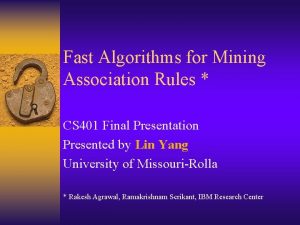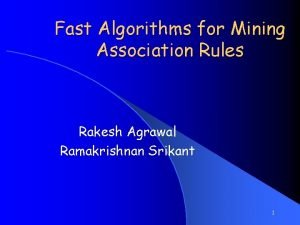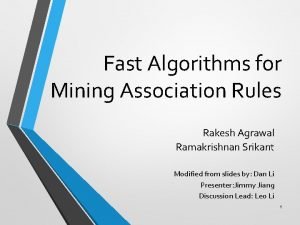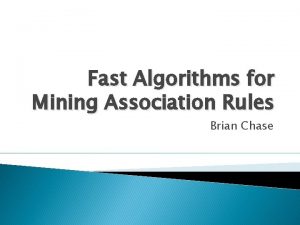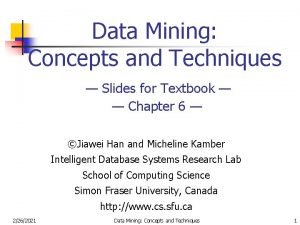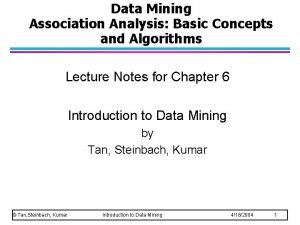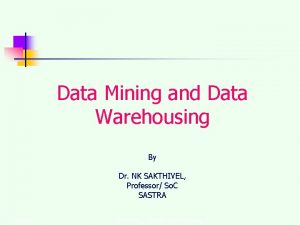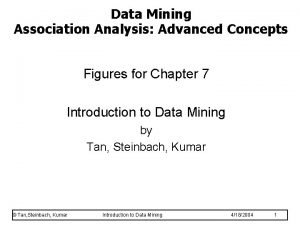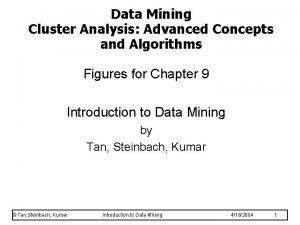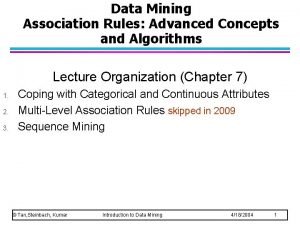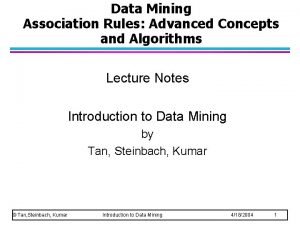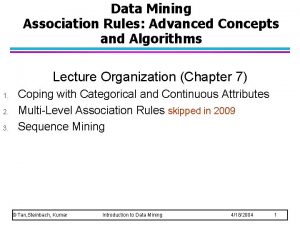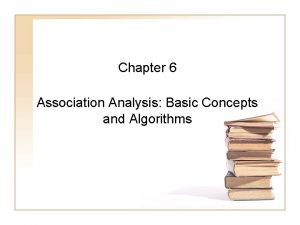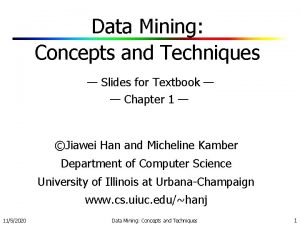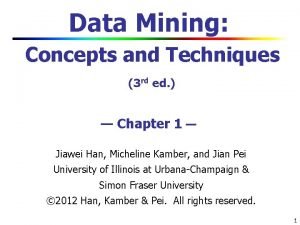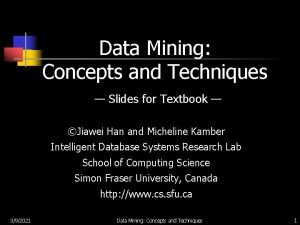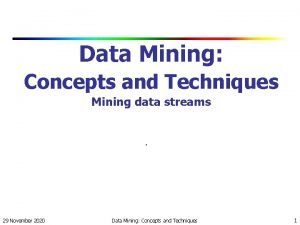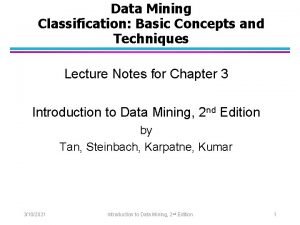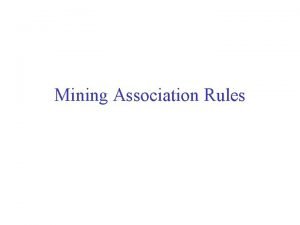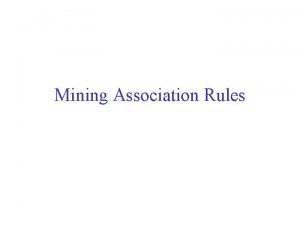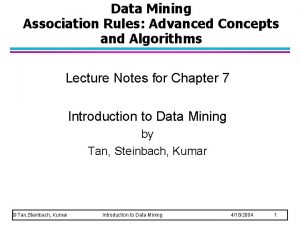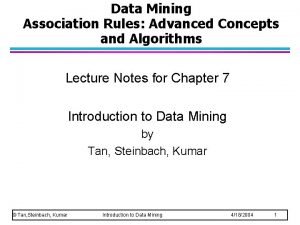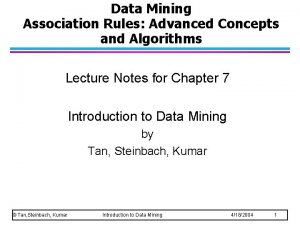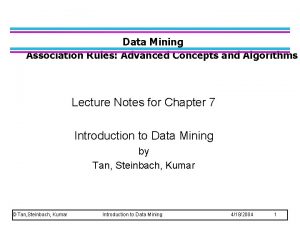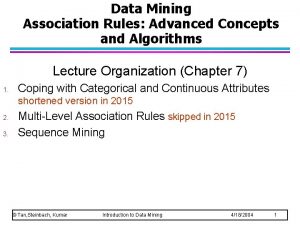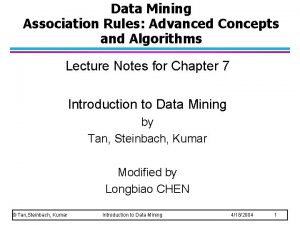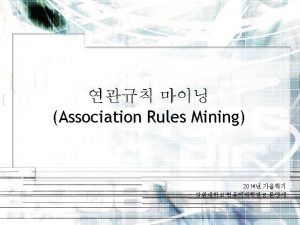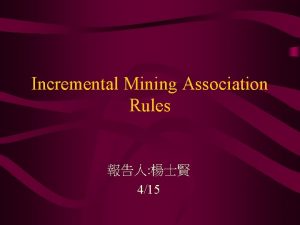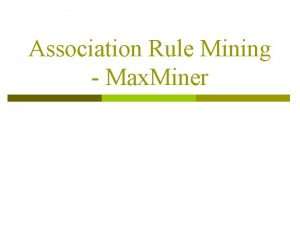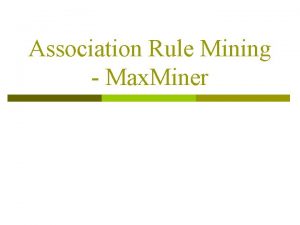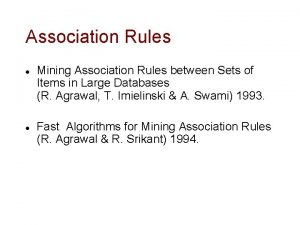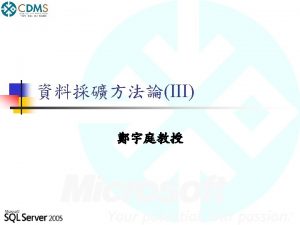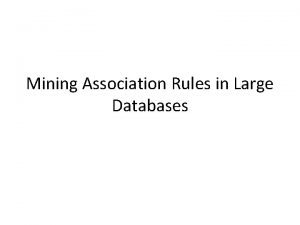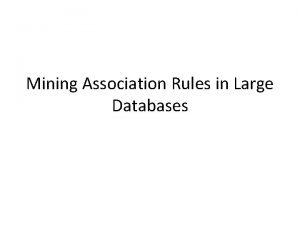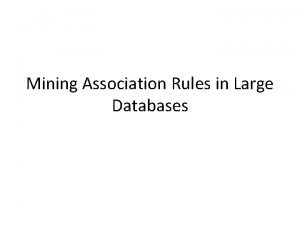Data Mining Association Rules Advanced Concepts and Algorithms






















- Slides: 22

Data Mining Association Rules: Advanced Concepts and Algorithms Lecture Notes Introduction to Data Mining by Tan, Steinbach, Kumar © Tan, Steinbach, Kumar Introduction to Data Mining 4/18/2004 1

Sequence Database: Object A A A B B C Timestamp 10 20 23 11 17 21 28 14 © Tan, Steinbach, Kumar Events 2, 3, 5 6, 1 1 4, 5, 6 2 7, 8, 1, 2 1, 6 1, 8, 7 Introduction to Data Mining 4/18/2004 2

Examples of Sequence Database Sequence Element (Transaction) Event (Item) Customer Purchase history of a given customer A set of items bought by a customer at time t Books, diary products, CDs, etc Web Data Browsing activity of a particular Web visitor A collection of files viewed by a Web visitor after a single mouse click Home page, index page, contact info, etc Event data History of events generated by a given sensor Events triggered by a sensor at time t Types of alarms generated by sensors Genome sequences DNA sequence of a particular species An element of the DNA sequence Bases A, T, G, C Element (Transaction) Sequence © Tan, Steinbach, Kumar E 1 E 2 E 1 E 3 E 2 Introduction to Data Mining E 2 E 3 E 4 Event (Item) 4/18/2004 3

Formal Definition of a Sequence l A sequence is an ordered list of elements (transactions) s = < e 1 e 2 e 3 … > – Each element contains a collection of events (items) ei = {i 1, i 2, …, ik} – Each element is attributed to a specific time or location l Length of a sequence, |s|, is given by the number of elements of the sequence l A k-sequence is a sequence that contains k events (items) © Tan, Steinbach, Kumar Introduction to Data Mining 4/18/2004 4

Examples of Sequence l Web sequence: < {Homepage} {Electronics} {Digital Cameras} {Canon Digital Camera} {Shopping Cart} {Order Confirmation} {Return to Shopping} > l Sequence of initiating events causing the nuclear accident at 3 -mile Island: (http: //stellar-one. com/nuclear/staff_reports/summary_SOE_the_initiating_event. htm) < {clogged resin} {outlet valve closure} {loss of feedwater} {condenser polisher outlet valve shut} {booster pumps trip} {main waterpump trips} {main turbine trips} {reactor pressure increases}> l Sequence of books checked out at a library: <{Fellowship of the Ring} {The Two Towers} {Return of the King}> © Tan, Steinbach, Kumar Introduction to Data Mining 4/18/2004 5

Formal Definition of a Subsequence l l l A sequence <a 1 a 2 … an> is contained in another sequence <b 1 b 2 … bm> (m ≥ n) if there exist integers i 1 < i 2 < … < in such that a 1 bi 1 , a 2 bi 1, …, an bin Data sequence Subsequence Contain? < {2, 4} {3, 5, 6} {8} > < {2} {3, 5} > Yes < {1, 2} {3, 4} > < {1} {2} > No < {2, 4} {2, 5} > < {2} {4} > Yes The support of a subsequence w is defined as the fraction of data sequences that contain w A sequential pattern is a frequent subsequence (i. e. , a subsequence whose support is ≥ minsup) © Tan, Steinbach, Kumar Introduction to Data Mining 4/18/2004 6

Sequential Pattern Mining: Definition l Given: – a database of sequences – a user-specified minimum support threshold, minsup l Task: – Find all subsequences with support ≥ minsup © Tan, Steinbach, Kumar Introduction to Data Mining 4/18/2004 7

Sequential Pattern Mining: Challenge l Given a sequence: <{a b} {c d e} {f} {g h i}> – Examples of subsequences: <{a} {c d} {f} {g} >, < {c d e} >, < {b} {g} >, etc. l How many k-subsequences can be extracted from a given n-sequence? <{a b} {c d e} {f} {g h i}> n = 9 k=4: Y_ <{a} © Tan, Steinbach, Kumar _YY _ _ _Y {d e} Introduction to Data Mining {i}> 4/18/2004 8

Sequential Pattern Mining: Example Minsup = 50% Examples of Frequent Subsequences: < {1, 2} > < {2, 3} > < {2, 4}> < {3} {5}> < {1} {2} > < {1} {2, 3} > < {2} {2, 3} > < {1, 2} {2, 3} > © Tan, Steinbach, Kumar Introduction to Data Mining s=60% s=80% s=60% 4/18/2004 9

Extracting Sequential Patterns l Given n events: i 1, i 2, i 3, …, in l Candidate 1 -subsequences: <{i 1}>, <{i 2}>, <{i 3}>, …, <{in}> l Candidate 2 -subsequences: <{i 1, i 2}>, <{i 1, i 3}>, …, <{i 1}>, <{i 1} {i 2}>, …, <{in-1} {in}> l Candidate 3 -subsequences: <{i 1, i 2 , i 3}>, <{i 1, i 2 , i 4}>, …, <{i 1, i 2} {i 1}>, <{i 1, i 2} {i 2}>, …, <{i 1} {i 1 , i 2}>, <{i 1} {i 1 , i 3}>, …, <{i 1}>, <{i 1} {i 2}>, … © Tan, Steinbach, Kumar Introduction to Data Mining 4/18/2004 10

Generalized Sequential Pattern (GSP) l Step 1: – Make the first pass over the sequence database D to yield all the 1 element frequent sequences l Step 2: Repeat until no new frequent sequences are found – Candidate Generation: u Merge pairs of frequent subsequences found in the (k-1)th pass to generate candidate sequences that contain k items – Candidate Pruning: u Prune candidate k-sequences that contain infrequent (k-1)-subsequences – Support Counting: u Make a new pass over the sequence database D to find the support for these candidate sequences – Candidate Elimination: u Eliminate candidate k-sequences whose actual support is less than minsup © Tan, Steinbach, Kumar Introduction to Data Mining 4/18/2004 11

Candidate Generation l Base case (k=2): – Merging two frequent 1 -sequences <{i 1}> and <{i 2}> will produce two candidate 2 -sequences: <{i 1} {i 2}> and <{i 1 i 2}> © Tan, Steinbach, Kumar Introduction to Data Mining 4/18/2004 12

Candidate Generation Examples l Merging the sequences w 1=<{1} {2 3} {4}> and w 2 =<{2 3} {4 5}> will produce the candidate sequence < {1} {2 3} {4 5}> because the last two events in w 2 (4 and 5) belong to the same element l Merging the sequences w 1=<{1} {2 3} {4}> and w 2 =<{2 3} {4} {5}> will produce the candidate sequence < {1} {2 3} {4} {5}> because the last two events in w 2 (4 and 5) do not belong to the same element © Tan, Steinbach, Kumar Introduction to Data Mining 4/18/2004 13

Timing Constraints (I) {A B} {C} <= xg {D E} xg: max-gap >ng ng: min-gap ms: maximum span <= ms xg = 2, ng = 0, ms= 4 Data sequence Subsequence Contain? < {2, 4} {3, 5, 6} {4, 7} {4, 5} {8} > < {6} {5} > Yes < {1} {2} {3} {4} {5}> < {1} {4} > No < {1} {2, 3} {3, 4} {4, 5}> < {2} {3} {5} > Yes < {1, 2} {3} {2, 3} {3, 4} {2, 4} {4, 5}> < {1, 2} {5} > No © Tan, Steinbach, Kumar Introduction to Data Mining 4/18/2004 14

Mining Sequential Patterns with Timing Constraints l Approach 1: – Mine sequential patterns without timing constraints – Postprocess the discovered patterns l Approach 2: – Modify GSP to directly prune candidates that violate timing constraints © Tan, Steinbach, Kumar Introduction to Data Mining 4/18/2004 15

Frequent Subgraph Mining Extend association rule mining to finding frequent subgraphs l Useful for Web Mining, computational chemistry, bioinformatics, spatial data sets, etc l © Tan, Steinbach, Kumar Introduction to Data Mining 4/18/2004 16

Graph Definitions © Tan, Steinbach, Kumar Introduction to Data Mining 4/18/2004 17

Representing Transactions as Graphs l Each transaction is a clique of items © Tan, Steinbach, Kumar Introduction to Data Mining 4/18/2004 18

Representing Graphs as Transactions © Tan, Steinbach, Kumar Introduction to Data Mining 4/18/2004 19

Apriori-like Algorithm Find frequent 1 -subgraphs l Repeat l – Candidate generation u Use frequent (k-1)-subgraphs to generate candidate k-subgraph – Candidate pruning Prune candidate subgraphs that contain infrequent (k-1)-subgraphs u – Support counting u Count the support of each remaining candidate – Eliminate candidate k-subgraphs that are infrequent In practice, it is not as easy. There are many other issues © Tan, Steinbach, Kumar Introduction to Data Mining 4/18/2004 20

Example: Dataset © Tan, Steinbach, Kumar Introduction to Data Mining 4/18/2004 21

Apriori on Graphs © Tan, Steinbach, Kumar Introduction to Data Mining 4/18/2004 22
 Aprioti
Aprioti Fast algorithms for mining association rules
Fast algorithms for mining association rules Fast algorithms for mining association rules
Fast algorithms for mining association rules Fast algorithms for mining association rules
Fast algorithms for mining association rules Association analysis: basic concepts and algorithms
Association analysis: basic concepts and algorithms Eck
Eck Association rules in data mining
Association rules in data mining Association rules in data mining
Association rules in data mining Association rules in data mining
Association rules in data mining Association rules in data mining
Association rules in data mining Association analysis advanced concepts
Association analysis advanced concepts Association analysis advanced concepts
Association analysis advanced concepts Association analysis advanced concepts
Association analysis advanced concepts Association analysis advanced concepts
Association analysis advanced concepts Types of attributes in data mining
Types of attributes in data mining Association analysis advanced concepts
Association analysis advanced concepts Data mining concepts and techniques slides
Data mining concepts and techniques slides Function of data mining
Function of data mining Data mining concepts and techniques slides
Data mining concepts and techniques slides Data mining concepts and techniques slides
Data mining concepts and techniques slides Multimedia data mining
Multimedia data mining Basic concepts in mining data streams
Basic concepts in mining data streams Basic concepts of classification in data mining
Basic concepts of classification in data mining
